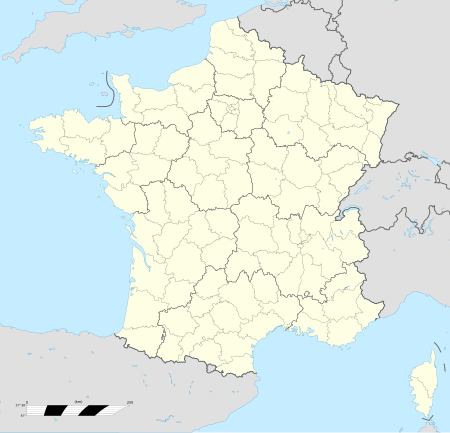
Since the mid 1980s, the largest source of electricity in France has been nuclear power, with a generation of 379.5 TWh in 2019 and a total electricity production of 537.7 TWh.[1] In 2018, the nuclear share was 71.67%,[2] the highest percentage in the world.[3]
Since June 2020, it has 56 operable reactors totalling 61,370 MWe, one under construction (1630 MWe), and 14 shut down or in decommissioning (5,549 MWe). In May 2022, EDF reported[4] that twelve reactors were shut down and being inspected for stress corrosion, requiring EDF to adjust its French nuclear output estimate for 2022 to 280–300 TWh; the estimate of the impact of the decrease in output on the Group's EBITDA for 2022 was assessed to be −€18.5 billion.
Électricité de France (EDF) – the country's main electricity generation and distribution company – manages the country's 56 power reactors.[5] EDF is fully owned by the French government.
Nuclear power was introduced in large quantities in France following the 1973 oil crisis according to the Messmer plan named for then prime minister Pierre Messmer. This was based on projections that large amounts of electric power would be required. Hindsight showed that too much nuclear power capacity was installed, and this led to relatively low production – a low average load factor of 61% by 1988 due to load following generation, and high electricity exports.[6] France exported 38 TWh of electricity to its neighbours in 2017.[7] However, the country still becomes a net importer of electricity when demand exceeds supply, such as in cases of very inclement weather, as in February 2012 when a cold snap, combined with French reliance on electric heating, led it to import large amounts of electricity from Germany.[8][9]
As of December 2023, according to data from Ember and the Energy Institute as processed by Our World in Data, France generates roughly two-thirds of its electricity from nuclear power, well above the global average of just under 10%. This heavy reliance on nuclear energy allows France to have one of the lowest carbon dioxide emissions per unit of electricity in the world at 85 grams of CO2 per kilowatt-hour, compared to the global average of 438 grams.[10]
- ^ "PRIS – Country Details". pris.iaea.org. Archived from the original on 6 June 2020. Retrieved 29 May 2022.
- ^ "PRIS – Country Details". pris.iaea.org. Archived from the original on 17 November 2019. Retrieved 29 May 2022.
- ^ "Nuclear share figures, 2009-2019". World Nuclear Association. May 2020. Retrieved 27 June 2020.
- ^ Cite error: The named reference
edf-2022was invoked but never defined (see the help page). - ^ "Nuclear Power in France". World Nuclear Association. September 2020. Archived from the original on 24 November 2020.
- ^ Cite error: The named reference
edf-historywas invoked but never defined (see the help page). - ^ "France still a net exporter" (PDF). Uk.reuters.com. 22 January 2013. Archived from the original (PDF) on 18 November 2018. Retrieved 1 October 2013.
- ^ Cite error: The named reference
reuters-20120214was invoked but never defined (see the help page). - ^ Cite error: The named reference
cookewas invoked but never defined (see the help page). - ^ "Data Insights". Our World in Data. Retrieved 8 April 2024.
